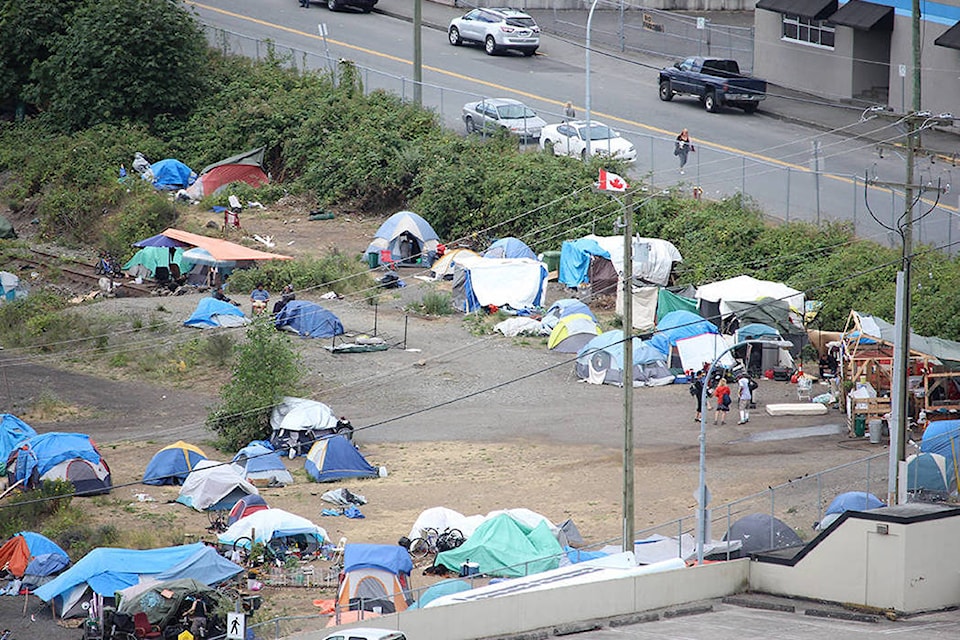Discontent City, the Schoolhouse Squat, the Wesley strip, and most recently the encampment at the Italian Fountain all have one thing in common – Nanaimo’s homeless population has continued to try congregate living.
Each of those encampments was untenable for various reasons, but ultimately, the failures of these attempts are that they were uncontrolled, unsanctioned and at unsustainable locations.
Without a designated congregate living site, Nanaimo’s homeless population is scattered throughout the city. People are living under bridges, in the doorways of businesses, in various parks and the forest – during a pandemic. It doesn’t have to be this way.
RELATED: City of Nanaimo fences off downtown park due to people experiencing homelessness
Over the summer the Cowichan Valley Regional District moved to set up designated tenting sites for homeless people living there. These sites were set up as an interim measure to give homeless folks a place to stay during the pandemic and hopefully limit the spread of COVID-19.
Five sites were established and two remain in operation. Both of those sites now feature what John Horn, executive director of the Cowichan Housing Association, calls ‘sleeping cabins.’ They’re eight-by-eight structures with insulation and baseboard heating. There are 39 cabins, which were purchased with a $310,000 federal grant.
These cabins are not a long-term solution to the homelessness crisis plaguing many cities in B.C., but they have some proven benefits.
Horn said that CHA staff spend far less time on the physical management of spaces and people because the clients don’t have to share a shelter space. That time is spent instead on helping the clients transition into a more stable housing situation.
Small-scale congregate living also gives a sense of community. Members of that community aren’t forced to tear down their tents and shuffle their belongings every morning. They have access to support workers and basic sanitation facilities like toilets and showers.
Another benefit is safety. When homeless people live in small encampments – approximately 10-20 people – they are far less likely to be victims of violent crime and harassment. And in the context of a managed site, predatory or chaotic elements cannot take over and pose a threat to neighbouring homes and businesses.
The City of Nanaimo has directed staff to investigate if sleeping cabins can work for Nanaimo too. Nanaimo has different challenges than the Cowichan Valley – there are more homeless people living in a smaller geographic area. The city will also have to develop its own funding model, find suitable locations, and develop partnerships with non-government organizations to staff and manage the sites.
Small group congregate living sites are not a solution for homelessness. But without designated spaces, Nanaimo’s homeless population will continue to establish unsanctioned sites. They will continue to live in spaces that are detrimental to their health and safety, and the safety of the community at large.
RELATED: Nanaimo’s health and housing task force presents action plan to address homelessness
Nanaimo’s health and housing task force has said that it will take $65.5 million in investments over five years to properly address Nanaimo’s homelessness crisis. Some may balk at that figure, however, the status quo is far more expensive. Nanaimo’s health and housing action plan estimates the potential return on investment can be as high as $30:$1.
More programs around mental health and addictions are needed, more funding for wrap-around supports are needed, and a supply of truly affordable housing is desperately needed. These programs don’t materialize overnight, but unsanctioned homeless encampments do.
The City of Nanaimo must take immediate action to establish congregate living sites and senior levels of government must properly fund the necessary programs to address the homelessness crisis long-term.
Everyone deserves to live in safety, dignity and community – something Nanaimo’s homeless have lived without for far too long.
Cole Schisler is the editor of the Ladysmith Chronicle, a Black Press publication. To read his Cole’s Notes columns, click here.
READ ALSO: City of Nanaimo report says Wesley Street camp was no longer sustainable
READ ALSO: Story of the year: Discontent City
